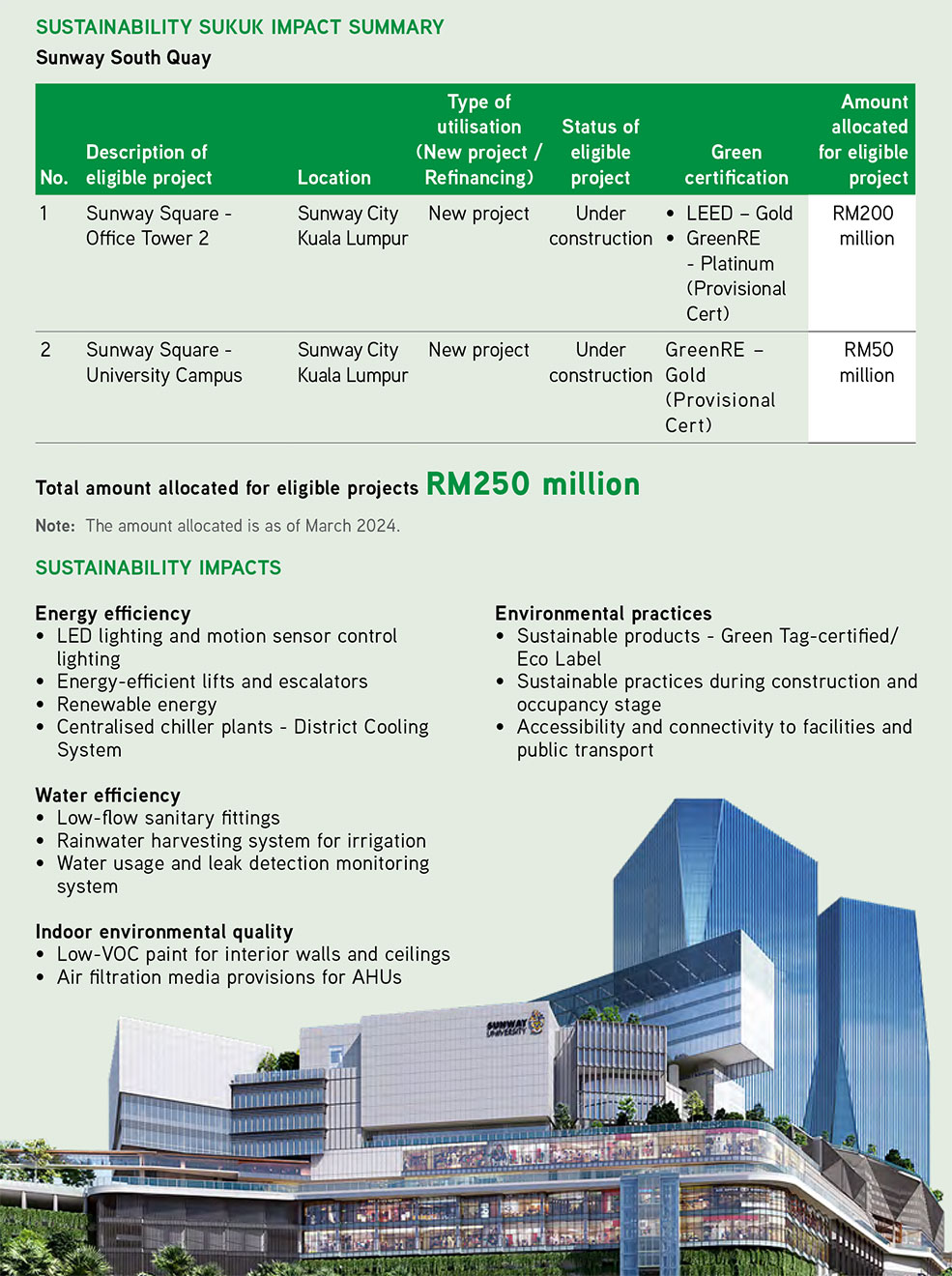2023
Scorecard
Our Sustainability Scorecard helps us to track our performance against our goals and targets. We integrated sustainability into Senior Management performance evaluations and Key Performance Indicators (KPIs), which are linked to remuneration.
Legend: Progress Tracking

On track and progressing steadily

Progress exceeds expectations

Progress exceeds expectations
| 2030 Targets | 2023 Performance |
|---|---|
Building Energy Intensity (BEI)/Energy Use Intensity (EUI) should stay below the annual targets set for the respective business divisions starting from 2022. (The business divisions should continue to stay below the BEI/EUI targets which will reduce by 3.5% to 4% on a y-o-y basis up to 2030 to align with the IPCC target of 45% reduction in carbon emissions by 2030.) |
Energy intensity targets and performance |
At least 40% of electricity from renewable energy sources by 2030 (5% locally generated, 35% purchased from green sources/solar farms) |
27,647 MWh (7%) of renewable energy was consumed |
| 40% waste diverted from landfills by 2030 |
8% of waste diverted from landfills |
| To achieve a reduction of 10% in overall water intensity target for managed assets by 2030 (Baseline year: 2015) |
The overall water intensity for managed assets increased by 16% from baseline |
| To reduce the Group’s reliance on municipal water supply by up to 50% through investment in alternative supplies and sources, thereby enhancing water security, by 2030 |
27% of water supply from non-municipal sources |
| To achieve at least five days of uninterrupted water supply from the onset of a water disruption event via a combination of onsite reserves and/or secured offsite supplies for all properties located within KL/Selangor by 2030 |
Four out of 14 of properties that are not located within Sunway City Kuala Lumpur (SCKL) can sustain themselves for at least five days during the onset of a water disruption event |
| All industrial property sites to be ISO 14001:2015 (Environmental Management Systems)-certified by 2030 |
Six out of six Building Materials sites are ISO 14001:2015 certified and maintained their certification |
| All ongoing construction sites are ISO 14001:2015 (Environmental Management Systems)-compliant |
16 ongoing construction sites are ISO 14001:2015-compliant |
| 2030 Targets | 2023 Performance |
|---|---|
| To review and initiate disclosures of Scope 3 emissions where relevant and applicable |
Five out of 15 Scope 3 emissions categories have been disclosed |
| All suppliers to disclose in accordance with ESG standards and framework where relevant and applicable |
In progress |
| 2030 Targets | 2023 Performance |
|---|---|
| To not be higher than the first quadrant of the DOSH national fatality rate by 2030 (1.46 fatalities for every 100,000 workers) |
Achieved a zero fatality rate |
| To reduce the occupational accident rate to 0.95 for every 1,000 workers, which is within quadrant 1 of the DOSH national accident rate, by 2030 |
Occupational accident rate of 4.36 for every 1,000 workers In |
| All business divisions (where relevant and applicable) to be ISO 45001:2018-certified and achieve OHS culture – Level 4 and above by 2030 |
|
| 36 learning and development (L&D) hours per employee (EG1 and above) |
40.6 learning hours per employee |
| 2030 Targets | 2023 Performance |
|---|---|
| To reach out and support over two million beneficiaries from 2015 to 2030 |
1,257,285 beneficiaries impacted from 2015 to 2023 |
| 2030 Targets | 2023 Performance |
|---|---|
| To maintain our position in the top 10% of the Industry Classification Benchmark (Real Estate) Supersector assessed by FTSE Russell |
Maintained position in the top 10% of the Industry Classification Benchmark (Real Estate) Supersector assessed by FTSE Russell |
| To achieve and/or maintain low/negligible Sustainalytics ESG Risk ensure transparent communication of our initiatives. Rating by 2030 |
Achieved Negligible ESG Risk Rating by Sustainalytics |
UN Sustainable Development
Goals (UN-SDGs)



